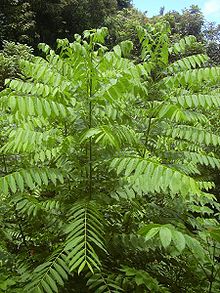Flora of Jamaica
The flora of Jamaica is divided into three ecoregions by the WWF : the Jamaican wet forest , the Jamaican dry forest and the mangroves on the coast.
Jamaica was originally almost completely covered with forest, there were only a few open areas. Most of the areas were destroyed by development and agriculture. About 6% of the land area is still in its original state. In 1995 Jamaica was named the country with the highest rate of deforestation by the World Resources Institute . Under the influence of increasing ecotourism, laws have been passed to protect the remaining habitats, but enforcement is difficult.
The proportion of endemic plants is very large. Of the 3003 known flowering plants , 28% occur only on the island, while the proportion of ferns is 14%. Almost a third of the bromeliads and orchids can only be found on the island.
Dry forest
The dry forest follows the coastline in a narrow strip. In the south it originally occupied larger areas, but these have been almost completely cut down and replaced by fields. The precipitation is between 700 and 1200 millimeters per year. The forests rarely reach higher than 200 meters above sea level. In terms of destruction, the dry forest is the hardest hit region. Among the endemic plants are the monotypic groups Portlandia and Jacaima, which belong to the subfamily of the silk plant family .
Wet forest

The wet forest covered most of the interior. Only the highest parts of the Blue Mountains are free from forests. Precipitation on the slopes of the highest peaks can be up to 5000 millimeters per year, especially during the two rainy seasons. Deforestation is not as advanced as in the lower dry forests, which is mainly due to the protected areas in Cockpit Country . The dominant species are the West Indian cedar ( Cedrela odorata ) and Mahoe ( Hibiscus elatus ).
Forests in the Blue Mountains and the neighboring John Crow Mountains are home to 600 species of flowering plants and 275 vascular spore plants . Many of them do not otherwise occur on the island. The forest in Cockpit Country is evergreen and largely untouched. There are plans to mine the large bauxite deposits below the area. Species that only occur here come mainly from the families Rubiaceae (11 species), Asteraceae (9), Gesneriaceae (8), Euphorbiaceae (7), Orchidaceae (7) and Myrtaceae (6). The exploration of the area is not complete, so further discoveries can be expected.
Mangroves and sea grass fields
Ten percent of the coast of Jamaica is covered with mangrove forests, around eleven percent of which are under protection. The plant species occurring here can be found on all coasts of the Greater Antilles .
The seagrass fields can be found mainly in the Pedrobank and along the southern coast. They are home to numerous animal species and have so far been largely intact.
See also
Individual evidence
- ↑ Archive link ( Memento of the original from September 27, 2007 in the Internet Archive ) Info: The archive link was inserted automatically and has not yet been checked. Please check the original and archive link according to the instructions and then remove this notice. Statistics from Earthtrends